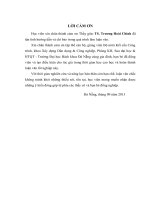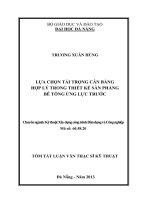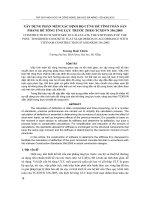Bê tông ứng lực trước - Prestressed Concrete
Bạn đang xem bản rút gọn của tài liệu. Xem và tải ngay bản đầy đủ của tài liệu tại đây (1.35 MB, 76 trang )
Civil Engineering Design (1)
Dr. C. Caprani
1
Civil Engineering Design (1)
Prestressed Concrete
2006/7
Dr. Colin Caprani,
Chartered Engineer
Civil Engineering Design (1)
Dr. C. Caprani
2
Contents
1. Introduction 3
1.1 Background 3
1.2 Basic Principle of Prestressing 4
1.3 Advantages of Prestressed Concrete 6
1.4 Materials 7
1.5 Methods of Prestressing 10
1.6 Uses of Prestressed Concrete 15
2. Stresses in Prestressed Members 16
2.1 Background 16
2.2 Basic Principle of Prestressed Concrete 19
3. Design of PSC Members 29
3.1 Basis 29
3.2 Minimum Section Modulus 32
3.3 Prestressing Force & Eccentricity 37
3.4 Eccentricity Limits and Tendon Profile 49
4. Prestressing Losses 56
4.1 Basis and Notation 56
4.2 Losses in Pre-Tensioned PSC 57
4.3 Losses in Post-tensioned PSC 60
5. Ultimate Limit State Design of PSC 66
5.1 Ultimate Moment Capacity 66
5.2 Ultimate Shear Design 71
Civil Engineering Design (1)
Dr. C. Caprani
3
1. Introduction
1.1 Background
The idea of prestressed concrete has been around since the latter decades of the 19th
century, but its use was limited by the quality of the materials at the time. It took until
the 1920s and ‘30s for its materials development to progress to a level where
prestressed concrete could be used with confidence. Freyssinet in France, Magnel in
Belgium and Hoyer in Germany were the principle developers.
The idea of prestressing has also been applied to many other forms, such as:
• Wagon wheels;
• Riveting;
• Barrels, i.e. the coopers trade;
In these cases heated metal is made to just fit an object. When the metal cools it
contracts inducing prestress into the object.
Civil Engineering Design (1)
Dr. C. Caprani
4
1.2 Basic Principle of Prestressing
Basic Example
The classic everyday example of prestressing is this: a row of books can be lifted by
squeezing the ends together:
The structural explanation is that the row of books has zero tensile capacity.
Therefore the ‘beam’ of books cannot even carry its self weight. To overcome this we
provide an external initial stress (the prestress) which compresses the books together.
Now they can only separate if the tensile stress induced by the self weight of the
books is greater than the compressive prestress introduced.
Concrete
Concrete is very strong in compression but weak in tension. In an ordinary concrete
beam the tensile stress at the bottom:
Civil Engineering Design (1)
Dr. C. Caprani
5
are taken by standard steel reinforcement:
But we still get cracking, which is due to both bending and shear:
In prestressed concrete, because the prestressing keeps the concrete in compression,
no cracking occurs. This is often preferable where durability is a concern.
Civil Engineering Design (1)
Dr. C. Caprani
6
1.3 Advantages of Prestressed Concrete
The main advantages of prestressed concrete (PSC) are:
Smaller Section Sizes
Since PSC uses the whole concrete section, the second moment of area is bigger and
so the section is stiffer:
Smaller Deflections
The larger second moment of area greatly reduces deflections for a given section size.
Increased Spans
The smaller section size reduces self weight. Hence a given section can span further
with prestressed concrete than it can with ordinary reinforced concrete.
Durability
Since the entire section remains in compression, no cracking of the concrete can
occur and hence there is little penetration of the cover. This greatly improves the
long-term durability of structures, especially bridges and also means that concrete
tanks can be made as watertight as steel tanks, with far greater durability.
AN
A N
RC PSC
Civil Engineering Design (1)
Dr. C. Caprani
7
1.4 Materials
Concrete
The main factors for concrete used in PSC are:
• Ordinary portland cement-based concrete is used but strength usually greater
than 50 N/mm
2
;
• A high early strength is required to enable quicker application of prestress;
• A larger elastic modulus is needed to reduce the shortening of the member;
• A mix that reduces creep of the concrete to minimize losses of prestress;
You can see the importance creep has in PSC from this graph:
Civil Engineering Design (1)
Dr. C. Caprani
8
Steel
The steel used for prestressing has a nominal yield strength of between 1550 to 1800
N/mm
2
. The different forms the steel may take are:
• Wires: individually drawn wires of 7 mm diameter;
• Strands: a collection of wires (usually 7) wound together and thus having a
diameter that is different to its area;
• Tendon: A collection of strands encased in a duct – only used in post-
tensioning;
• Bar: a specially formed bar of high strength steel of greater than 20 mm
diameter.
Prestressed concrete bridge beams typically use 15.7 mm diameter (but with an area
of 150 mm
2
)7-wire super strand which has a breaking load of 265 kN.
Civil Engineering Design (1)
Dr. C. Caprani
9
Civil Engineering Design (1)
Dr. C. Caprani
10
1.5 Methods of Prestressing
There are two methods of prestressing:
• Pre-tensioning: Apply prestress to steel strands before casting concrete;
• Post-tensioning: Apply prestress to steel tendons after casting concrete.
Pre-tensioning
This is the most common form for precast sections. In Stage 1 the wires or strands are
stressed; in Stage 2 the concrete is cast around the stressed wires/strands; and in
Stage 3 the prestressed in transferred from the external anchorages to the concrete,
once it has sufficient strength:
Civil Engineering Design (1)
Dr. C. Caprani
11
In pre-tensioned members, the strand is directly bonded to the concrete cast around it.
Therefore, at the ends of the member, there is a transmission length where the strand
force is transferred to the concrete through the bond:
At the ends of pre-tensioned members it is sometimes necessary to debond the strand
from the concrete. This is to keep the stresses within allowable limits where there is
little stress induced by self with or other loads:
Civil Engineering Design (1)
Dr. C. Caprani
12
Post-tensioned
In this method, the concrete has already set but has ducts cast into it. The strands or
tendons are fed through the ducts (Stage 1) then tensioned (Stage 2) and then
anchored to the concrete (Stage 3):
The anchorages to post-tensioned members must distribute a large load to the
concrete, and must resist bursting forces as a result. A lot of ordinary reinforcement is
often necessary.
A typical tendon anchorage is:
Civil Engineering Design (1)
Dr. C. Caprani
13
And the end of a post-tensioned member has reinforcement such as:
Civil Engineering Design (1)
Dr. C. Caprani
14
Losses
From the time the prestress is applied, the prestress force gradually reduces over time
to an equilibrium level. The sources of these losses depend on the method by which
prestressing is applied.
In both methods:
• The member shortens due to the force and this relieves some of the prestress;
• The concrete shrinks as it further cures;
• The steel ‘relaxes’, that is, the steel stress reduces over time;
• The concrete creeps, that is, continues to strain over time.
In post-tensioning, there are also losses due to the anchorage (which can ‘draw in’ an
amount) and to the friction between the tendons and the duct and also initial
imperfections in the duct setting out.
For now, losses will just be considered as a percentage of the initial prestress.
Civil Engineering Design (1)
Dr. C. Caprani
15
1.6 Uses of Prestressed Concrete
There are a huge number of uses:
• Railway Sleepers;
• Communications poles;
• Pre-tensioned precast “hollowcore” slabs;
• Pre-tensioned Precast Double T units - for very long spans (e.g., 16 m span for
car parks);
• Pre-tensioned precast inverted T beam for short-span bridges;
• Pre-tensioned precast PSC piles;
• Pre-tensioned precast portal frame units;
• Post-tensioned ribbed slab;
• In-situ balanced cantilever construction - post-tensioned PSC;
• This is “glued segmental” construction;
• Precast segments are joined by post-tensioning;
• PSC tank - precast segments post-tensioned together on site. Tendons around
circumference of tank;
• Barges;
• And many more.
Civil Engineering Design (1)
Dr. C. Caprani
16
2. Stresses in Prestressed Members
2.1 Background
The codes of practice limit the allowable stresses in prestressed concrete. Most of the
work of PSC design involves ensuring that the stresses in the concrete are within the
permissible limits.
Since we deal with allowable stresses, only service loading is used, i.e. the SLS case.
For the SLS case, at any section in a member, there are two checks required:
At Transfer
This is when the concrete first feels the prestress. The concrete is less strong but the
situation is temporary and the stresses are only due to prestress and self weight.
At Service
The stresses induced by the SLS loading, in addition to the prestress and self weight,
must be checked. At service stage, the concrete has its full strength but losses will
have occurred and so the prestress force is reduced.
The ultimate capacity at ULS of the PSC section (as for RC) must also be checked. If
there is insufficient capacity, you can add non-prestressed reinforcement. This often
does not govern.
Civil Engineering Design (1)
Dr. C. Caprani
17
Notation
For a typical prestressed section:
We have:
t
Z
Section modulus, top fibre
t
I
y
=
;
b
Z
Section modulus, bottom fibre
b
I
y
=
− (taken to be negative);
tt
f
Allowable tensile stress at transfer;
tc
f
Allowable compressive stress at transfer;
s
t
f
Allowable tensile stress in service;
s
c
f
Allowable compressive stress ain service;
t
M
The applied moment at transfer;
s
M
The applied moment in service;
α
The ratio of prestress after losses (service) to prestress before losses, (transfer).
Civil Engineering Design (1)
Dr. C. Caprani
18
Allowable Stresses
Concrete does have a small tensile strength and this can be recognized by the
designer. In BS 8110, there are 3 classes of prestressed concrete which depend on the
level of tensile stresses and/or cracking allowed:
Stresses Class 1 Class 2 Class 3
Tension:
tt
f
1 N/mm
2
0.45
ci
f
for pre-tensioned members
0.36
ci
f
for post-tensioned members
At transfer
Compression:
tc
f
0.5
ci
f
*
Tension:
s
t
f
0 N/mm
2
0.45
ci
f
(pre)
0.36
ci
f
(post)
See code table
In service
Compression:
s
c
f
0.33
cu
f
* there are other requirements for unusual cases – see code
Civil Engineering Design (1)
Dr. C. Caprani
19
2.2 Basic Principle of Prestressed Concrete
Theoretical Example
Consider the basic case of a simply-supported beam subjected to a UDL of w kN/m:
In this case, we have the mid-span moment as:
2
8
C
wL
M =
Also, if we assume a rectangular section as shown, we have
the following section properties:
3
22
12
66
tb
bd
Abd I
bd bd
ZZ
==
==
Therefore the stresses at C are:
CC
tb
tb
M
M
Z
Z
σσ
==
A
V
A
V
B
B
w
L
C
b
d
Civil Engineering Design (1)
Dr. C. Caprani
20
Case I
If we take the beam to be constructed of plain concrete (no reinforcement) and we
neglect the (small) tensile strength of concrete (
0
t
f
=
), then, as no tensile stress can
occur, no load can be taken:
0
I
w
=
Case II
We consider the same beam, but with centroidal axial prestress as shown:
Now we have two separate sources of stress:
A
V
A
V
B
B
w
L
C
P
P
+
+
-
+ =
C
t
M
Z
C
b
M
Z
P
A
C
t
PM
A
Z
+
C
b
PM
A
Z
−
P
A
Civil Engineering Design (1)
Dr. C. Caprani
21
For failure to occur, the moment caused by the load must induce a tensile stress
greater than
P
A
. Hence, just prior to failure, we have:
2
2
8
8
C
bb
b
II
M
PwL
Z
AZ
ZP
w
L
A
==
=
Note that we take
Compression as positive and tension as negative.
Also, we will normally
take
b
Z
to be negative to simplify the signs.
Case III
In this case we place the prestress force at an eccentricity:
Using an equilibrium set of forces as shown, we now have three stresses acting on the
section:
A
V
A
V
B
B
w
L
C
P
P
e
e
P
e
=
P
M
Pe=
N.A.
Civil Engineering Design (1)
Dr. C. Caprani
22
Thus the stresses are:
Hence, for failure we now have:
2
8
C
bb
b
III
b
MPPe
ZAZ
Z
PPe
w
L
AZ
=+
⎛⎞
=+
⎜⎟
⎝⎠
If, for example, we take
6
d
e =
, then:
222
8616
2
6
bb
III II
ZPPd ZP
ww
LAbd LA
⎛⎞
=+==×
⎜⎟
⎝⎠
So the introduction of a small eccentricity has doubled the allowable service load.
+
+
-
+ =
t
Pe
Z
b
Pe
Z
P
A
C
tt
PM Pe
A
ZZ
+−
C
bb
PM Pe
A
ZZ
−+
+
-
C
t
M
Z
C
b
M
Z
+
P
A
Civil Engineering Design (1)
Dr. C. Caprani
23
Numerical Example – No Eccentricity
Prestress force (at transfer), P = 2500 kN. Losses between transfer and SLS = 20%.
Check stresses. Permissible stresses are:
tt
f
= -1 N/mm
2
tc
f
= 18 N/mm
2
s
t
f
= 0 N/mm
2
s
c
f
= 22 N/mm
2
The section is rectangular, 300 wide and 650 mm deep. It is simply supported
spanning 12 m with dead load equal to self weight and a live load of 6 kN/m
(unfactored). The prestress force is applied at the centroid.
First calculate the section properties for a 300×650 beam:
A = 300×650
= 195 000 mm
2
Second moment of area, I, is bh
3
/12:
I = 300×650
3
/12
= 6866×10
6
mm
4
Section modulus for the top fibre, Z
t
, is I/x. For a rectangular section 650 mm deep,
the centroid is at the centre and this is:
Z
t
= 6866×10
6
/325 = 21.12×10
6
mm
3
(some people use the formula for rectangular sections, Z
t
= bh
2
/6 which gives the
same answer).
x=h/2
h
Civil Engineering Design (1)
Dr. C. Caprani
24
Similarly, Z
b
= -21.12×10
6
mm
3
(sign convention: Z
b
is always negative as the
measurement to the bottom fibre is negative).
The only applied loading at transfer is the self weight which is (density of concrete) ×
(area). Hence:
self weight = 25(0.3 × 0.65) = 4.88 kN/m
The maximum moment due to this loading is:
transfer moment, M
t
= 4.88(12)
2
/8 = 87.8 kNm
The total loading at SLS is this plus the imposed loading, i.e.:
SLS moment, M
s
= (4.88 + 6)(12)
2
/8
= 195.8 kNm
The prestress causes an axial stress of P/A = 2500×10
3
/ 195 000 = 12.8 N/mm
2
:
wl
2
/8
l
w
P
Civil Engineering Design (1)
Dr. C. Caprani
25
At transfer, the stress due to prestress applies and, after the beam is lifted, the stress
due to self weight. The self weight moment at the centre generates a top stress of:
M
t
/Z
t
= 87.8×10
6
/ 21.12×10
6
= 4.2 N/mm
2
.
Hence the transfer check at the centre is:
At SLS, the prestress has reduced by 20%. The top and bottom stresses due to applied
load (M
s
) are ±195.8×10
6
/21.12×10
6
= ±9.3 N/mm
2
. Hence the SLS check is:
10.2
9.3
-9.3
19.5
0.9
9
9
+ =
Prestress Self Weight Total
12.8
12.8
4.2
-4.2
17.0
8.6
9
9
+ =
Prestress Self Weight Total









